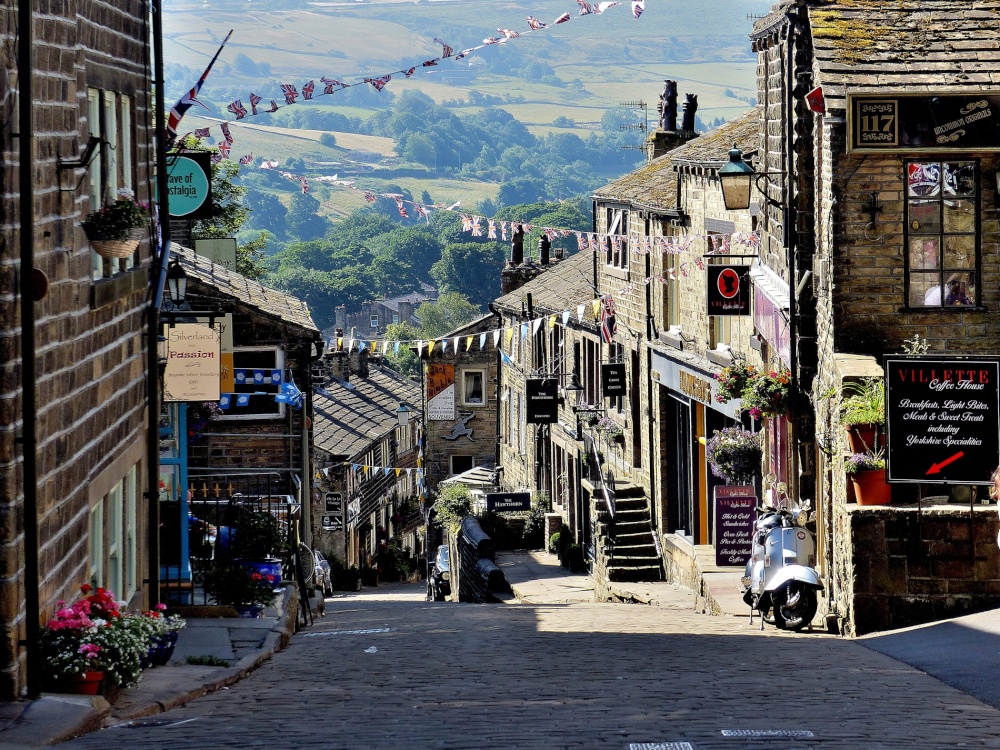
Main street, Haworth - Image by PicturesOfEngland.com member Tom Curtis (view gallery)
There are many pretty streets throughout England's historic towns and villages. Here we list just a few of the more famous ones for you to discover, with links to more pictures of each place so you can explore these beautiful towns and villages and see more of what they have to offer. If you know of any pretty streets in England that we do not list here but you think we should, please kindly let us know by posting in the forum here. Thank you.
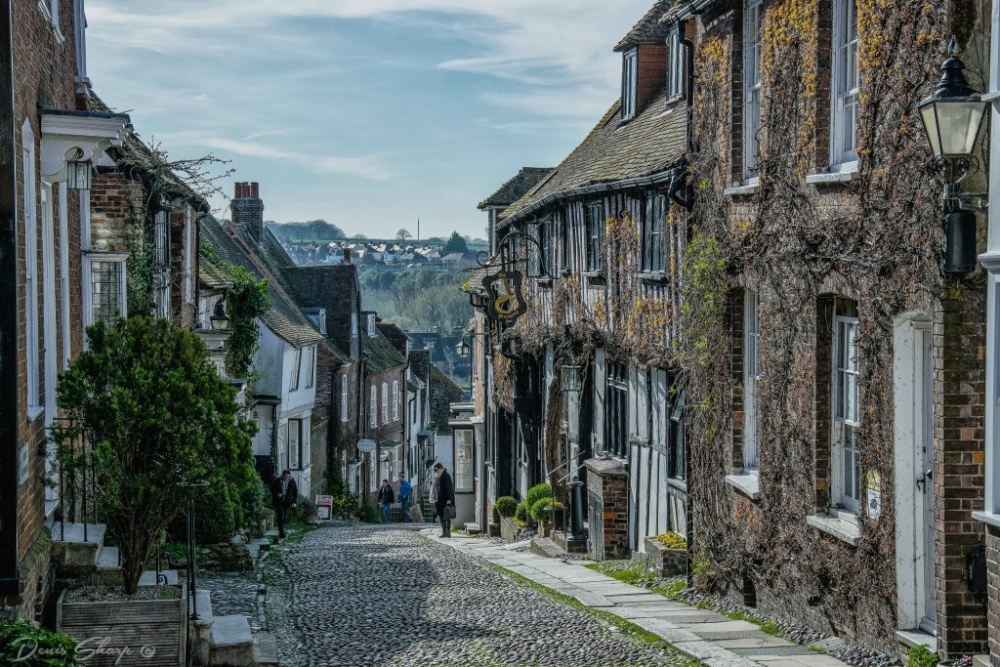
Mermaid Street, Rye, Sussex - Image by PicturesOfEngland.com member Denis Sharp (view gallery)
Regarded by many as the prettiest town in England, Rye is a very popular place to visit along the south coast of England in Sussex. Standing on a hill, Rye is full of pretty pictures, with its winding cobbled streets and old timber framed buildings and windmill. Once an important harbour town in Sussex, Rye now lies 2 miles inland from the sea as a result of a changing coast line. Burnt down by the french in 1377 and again in 1448 the fortified town of Rye has had a turbulent history leaving it with a mix of buildings dating from the 15th through to the 18th century.
ID#4
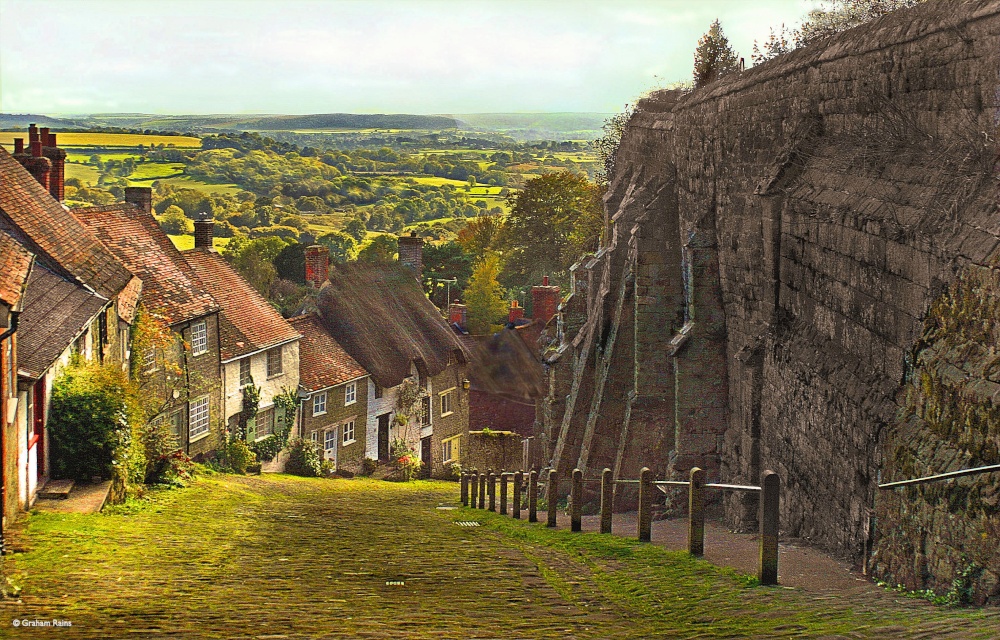
Shaftesbury in Dorset - Image by PicturesOfEngland.com member Graham Rains (view gallery)
Shaftsbury is Dorset's only hill-top town, with its long history and good views it is particularly attractive to tourists. It started life as a West Saxon fortified town, in the year 880 it was given a nunnery by King Alfred, his daughter, Ethelgiva became the first abbess, and around this grew an Anglo-Saxon town. In 981 Edward the Martyr was buried here. The convent flourished right until the time of the Reformation, when the vast church built with the riches garnered over centuries was destroyed.
In medieval times, Shaftsbury was a place of pilgrimage with many pilgrims visiting the town to worship at the shrine of St. Edward. In the 13th-century Shaftsbury was granted the rights to hold a weekly market, and in the 14th-century this was extended to two markets.
Today, on its high plateau Shaftsbury with its quaint corners and attractive little streets is a magnet for visitors. Its most famous street, Gold Hill slopes steeply down, this is quite possibly the most photographed street in Dorset. At its top is an excellent small museum where visitors can explore the town's unique farming and button manufacturing heritage. There are displays of locally made buttons and many implements used on farms; these include - scythes and Shepherd's crooks. There is a set of Shaftsbury weights and measures from the 17th-century and a fire engine from the mid 18th-century.
St.Peters Church is noted for its crypt and vaulted porch; there is an elaborately carved north parapet, and fine 15th-century stained glass. The excavated remains of the former abbey church lie within a walled garden.
The town's Grosvenor Hotel is a former coaching inn which dates from the 16th-century, although the interior is much altered some of the old features remain, and the exterior radiates all the charm of a by-gone age when it was a busy coaching centre. The arrival of the railways left the town somewhat bereft for a time, but the age of the modern motor car put it once more on the tourist trail.
During the season the town hosts several events including an annual carnival held each October, and the celebrated Gold Hill Fair is in July.
Shaftsbury has splendid views of Blackmoor Vale, and is within easy reach of the Salisbury Plains.
ID#30894
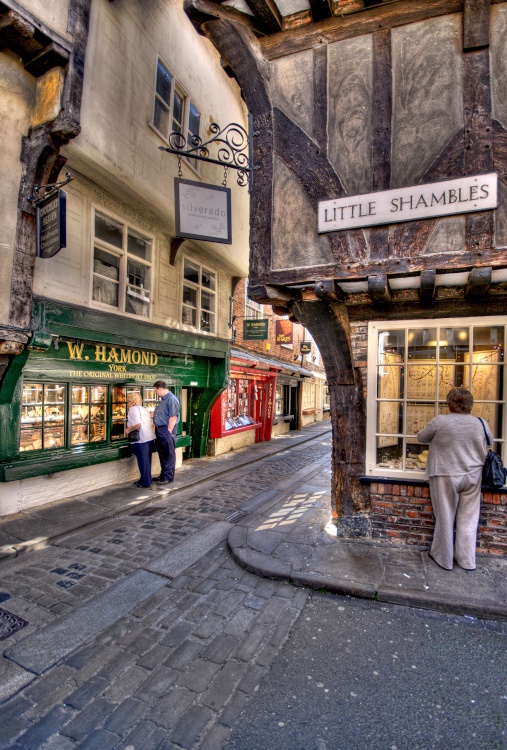
The Shambles - Image by PicturesOfEngland.com member Sarah Dawson (view gallery)
The jewell in York's crown is unquestionably its towering Cathedral. The magnificent Minster dominates York and has towered over the little streets and houses of the old town for centuries. The Minster was started at the beginning of the 13th-century by Archbishop Walter de Grey and about 250 years later the hugh 230ft central tower was completed. This house of God is awe-inspiring and of breathtaking grandeur, it contains many treasures and it's glorious windows are said to contain more than half the medieval stained glass in England. The 100 windows cover a period of 800 years and the oldest window is said to date around 1150. The cathedral contains exquisite statues, intricate carvings and fine brasses, it is of immense splendour and it is not therefore surprising that each day sees it thronged with hundreds of visitors from all corners of the world. It is indeed the finest Gothic cathedral in England.
Another vista of pure delight is The Shambles. It is perhaps, the most famous medieval street in the country and certainly one of the best preserved of it's kind in Europe. The countless visitors who throng the Minster all find their way to The Shambles and Stonegate where medieval buildings of all shapes and sizes cling together as if for support.
York has a long history that dates back to the days when it was Capital of a British province under the Romans. Today, the city of York remains the most important city in the north of England with reminders everywhere of a great historic and cultural past. There are buildings from all periods of history, and of special interest are the old city walls which are a fascinating reminder of the age of this great city.
Latter day history of York is strongly linked to the railways and the National Railway Museum is home to some grand old locomotives and rolling stock.
York has many churches, abbey's, grand houses and halls that are of great historical value and to see and enjoy all that York has to offer will take time. Your visit here should not be a hurried trip, it should be a time of leisure in which to drink deep of all the blessings bestowed on this beautiful place.
There is some commanding countryside in these parts and you are not far from the famous Moors. The lovely River Ouse flows through York and several pubs and inns can be found interspersed in local villages on the river banks. There is an good race-course and a nearby golf course. For shopping you have the delights of The Shambles as well as all the known High St stores.
The City offers excellent hotels and some very fine restaurants.
ID#161

Main street, Haworth - Image by PicturesOfEngland.com member Tom Curtis (view gallery)
Haworth is famous the world over for its connections with the Bronte sisters, the famous novelists. They lived at Haworth Parsonage which is now a museum cared for and owned by the Bronte Society. This is where the bronte sisters once lived and wrote some of their most famous novels including Wuthering Heights, Jane Eyre and Agnes Grey. The village also hosts once a year a fantastic 1940's weekend.
ID#417
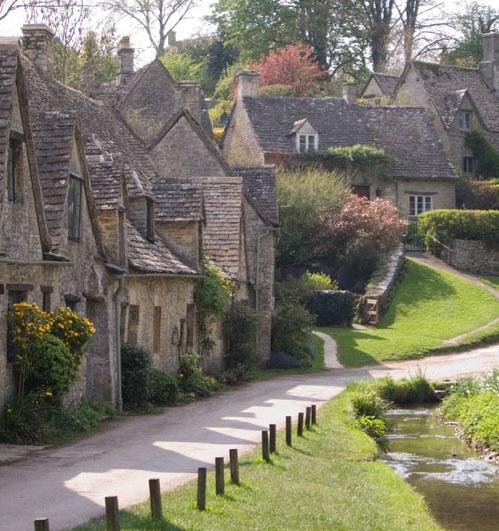
Cottages at Bibury, in the Cotswolds - Image by PicturesOfEngland.com member John Ware (view gallery)
William Morris, the 19th-century artist and poet thought Bibury to be the most beautiful village in England. This sentiment was echoed by another Victorian, J. Arthur Gibbs, wrote of it elequently in A Cotswold Village, published in 1898.
The slow moving River Coln wends its way between wooded banks and is spanned by a road bridge dated 1790. Many of the stone-built houses have gardens than run down to meet this sparkling river, and on the banks of the mill stream which flows into the Coln, stands a terrace of gabled and stone-tiled cottages called Arlington Row. The cottages were converted from a 14th-century sheephouse in the early 17th-century to provide housing for weavers supplying cloth for the nearby Arlington Mill. These cottages are now owned by the National Trust and Arlington Mill is now a museum and houses a fine collection of furniture from the Cotswold Arts and Crafts movement.
There is a rich variance of properties in Bibury, some are of timber frame with thatched roofs, but mostly they are built of Honey coloured Cotswold stone, having steep gables and tall chimneys, often with delightful small stone clad windows and nearly all submerged in seemingly motionless green foilage. It is these wonderful houses, so traditional of the Cotswolds, that causes Bibury to be thronged with an endless stream of visitors throughout, not only high summer but all the year round.
The centre of Bibury is the square, overlooked by the Saxon Church of St. Mary. St. Mary's has many later additions, mostly Norman and Medieval, but much of the Saxon work is still visible.
Bibury Court is of Jacobean origin and The Swan is a pleasant early coaching inn. There are several other inns and public houses
both in and around the village.
This is an enchanting village and well worth a visit for it is a village that possesses the dream-like quality of a Christmas card.
For further information, please visit: www.bibury.com
ID#296
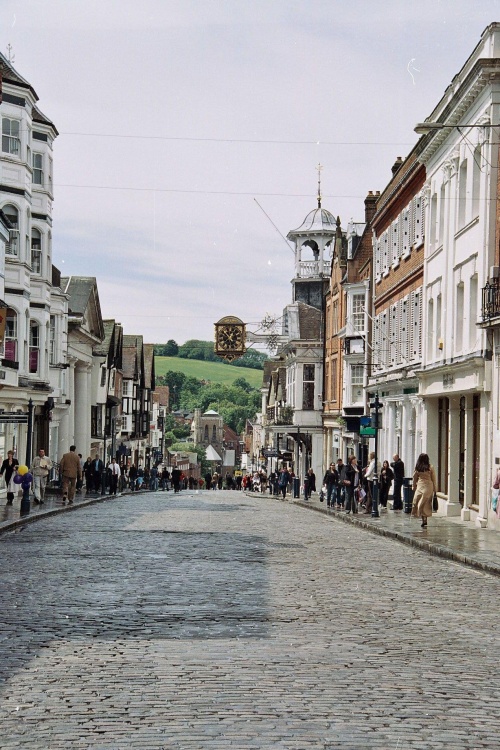
High Street, Guildford, Surrey - Image by PicturesOfEngland.com member Edina Hasulyo (view gallery)
Fashionable county town of the County of Surrey. It has a High Street of mellow Georgian buildings, and despite changing times Guildford is a town that has managed to maintain its charm and character.
The River Wey has been central to the life of the town for centuries. Its beautiful Guildhall stands in the High Street which runs down to the banks of the river. This is an impressive Tudor building with a 17th century facade and a protruding clock bearing the date 1683. Tall windows and an elegant balcony complete this attractive building which also has a bell-turret. In the old courtroom there is a set of standard measures presented to Guildford by Queen Elizabeth I, one of the few complete sets from this period still in existence.
Guildford cathedral occupies a commanding position on Stag Hill. This is one of the few churches built during the 20th century, it was begun in 1936 but was delayed by the advent of the Second World War, it was finally finished and consecrated in 1961. It has an eye catching red brick exterior to a simplified Gothic design by Sir Edward Maufe.
Away from the High Street stands ruined Guildford Castle, this was built by Henry II during the 12th century and is located on a mound. Here, from the castle keep visitors can take in good views of the town. Housed within the castle is the museum of local history, this has a collection dedicated to Lewis Caroll the author of Alice in Wonderland, who died in Guildford at the end of the 19th century and whose body lies buried in Mount Cemetery.
Leisure is catered for by the Spectrum Leisure Complex is in Parkway. The river life of the Wey provides endless entertainment with ducks and swans waddling out of the water in search of food - usually there are children are at hand to help out with feeding. Further down the river interesting old mills can be seen and many wharfs and boathouses can be found where boats can be hired or river trips arranged. The town's original barge building site is at Dapdune Wharf this is now in the hands of the National Trust and has a visitor centre recalling three hundred years of waterway history. Mostly, for centuries the waters of the river had only a commercial usage, it has locks built during the 17th century, now-a-days it is the scene of pleasure with gaily painted narrow boats and other rivercraft gliding sedately between banks lined with willow trees dipping gracious branches at the waters edge.
The Civic Hall is the home of Guildford Philharmonic Orchestra and is a venue for concerts and other entertainments, whilst the Yvonne Arnaud Theatre regularly presents shows direct from London's West End. This theatre is pleasantly situated at the side of the river just a short distance from Town Bridge.
The students attending Surrey University give the town a youthful feel. The university has sites in Guildford, one at Stag Hill and the other a short distance out of the town. The North Downs Way runs right through Guildford with the stretch towards Dorking being particularly open and attractive.
Around the town there are upmarket hotels and restaurants, historic inns, fine shops, cafe's and interesting public houses. With its close proximity to London, plus its historic connections Guildford attracts many of its residents from the business sector of London. It is a wholly interesting town which offers much to visitors, who should they tarry for a day or so get to experience a pleasant way of life with a charm long since gone from many other places.
ID#232
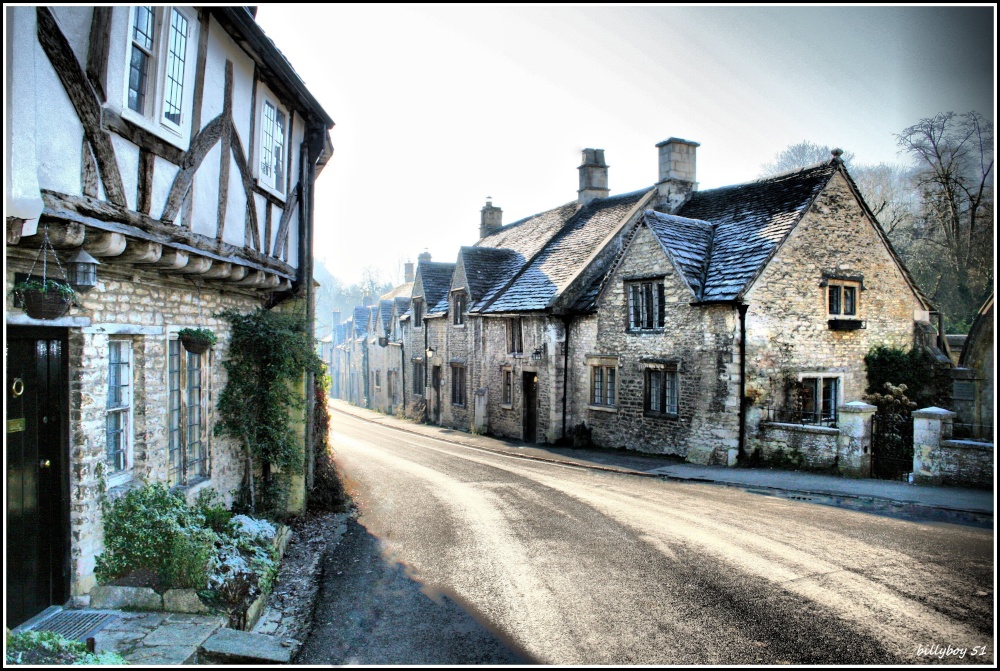
Castle Combe, Main Street - Image by PicturesOfEngland.com member Bill Swan (view gallery)
Often cited as 'the most picturesque village in all of England', this award-winning place is one of the jewels in England's crown and one of the highlights of any visit to England. The village is situated on the southern edge of the Cotswolds, in a valley, and found its wealth in the wool trade with the villages picturesque river 'ByBrook' powering the mills. Visitors to the village can park at the top of the hill and wonder down into the village where they can enjoy walking round this lovely fairytale-like setting. Most buildings are made of the typical Cotswold limestone with its manor being built of the stone from the Norman castle that once sat above the village.
In its center is the 14th century Market Cross with old water pump beside it. The best view is said to be from by the old weavers cottage across the bridge.
The village has its own small museum containing local artifacts, old photos and maps, and a look at the history of the village and surrounding area.
ID#313
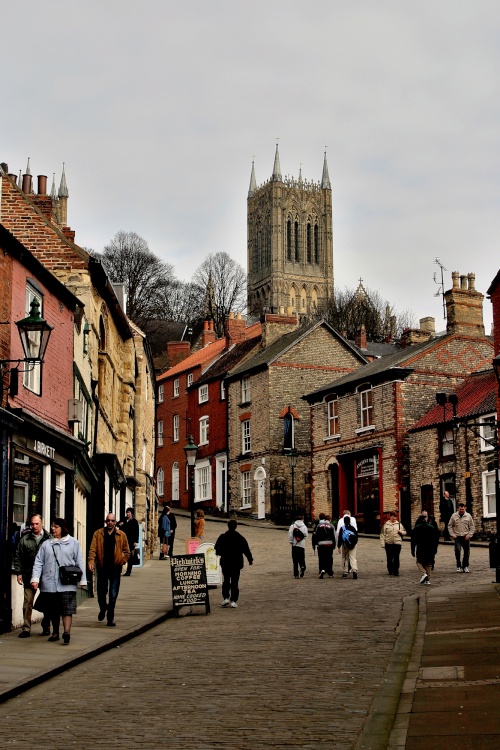
Steep Hill, Lincoln - Image by PicturesOfEngland.com member Tom Curtis (view gallery)
This fine cathedral City was called Lindon by the Ancient Britons' and later the Romans' knew it as Lindum. In AD48 a Roman garrison was set up to command the meeting of the highways of Ermine Street and the Fosse Way. The City has a long illustrious history, it became the centre of a Bishopric in 1072 and its cathedral church was begun soon after. However much of the cathedral we see today was built following an earthquake in 1185, with very little of the earlier church remaining.
For many it is the amazing cathedral which draws the crowd, its three mighty towers rising to meet the sky are visible from all corners. These are a spectacular sight at any time but lit against a night-time sky they show an almost incomparable Gothic beauty. Inside the cathedral there are magnificent columns of Purbeck stone, and the eye is immediately drawn to what are known as "the crazy vaults of Lincoln" - a complicated system of arches above the choir. The whole of the interior is dominated by the glorious stained glass window of the east end. Within the cathedral there are numerous historic treasures, it is a church with many reminders of its ancient past, it is a constant source of fascination that is simply overwhelming.
Lincoln is well known for the magic and sheer scale of its historic buildings. Its castle was built on a Roman site by William the Conqueror in 1086, and in cobbled Castle Square handsome Georgian buildings stand side on with black and white timber framed properties from Tudor times. Looking around visitors are instantly reminded of Lincoln's 2000 year history, and yet the city has flourished, new buildings have appeared making it not simply a place from the past but a fine city focused on the requirements of the present. It is a place of culture, business and commerce, with an emphasis on leisure facilities, entertainment and the very best of retail shops.
One of the pleasures of Lincoln is to enjoy a boat trip around the city from the waters of the River Witham and the Fossdyke Roman canal, these operate from Brayford Wharfe North and give visitors the opportunity of seeing historic Lincoln from a different vantage point.
There is a fine University here, its buildings can be seen at the side of Brayford Pool. The city also has numerous pubs, many are historic, retaining features from the past. These include, the 14th-century Wig and Mitre, the Lion and Snake which is close to both the cathedral and the castle, the Victoria - a totally un-restored atmospheric building close to the castle, the Magna Carta at the top of Steep Hill, and the popular Pypewick Inn, an Alehouse of the late 18th-century at the side of the Fossdyke Canal. Visitors also find a wide range of comfortable hotels both in the city and its suburbs.
The city offers visitors a vast choice of attractions, it concentrates on the arts and features many annual events throughout the year culminating in Christmas festivities, including a Christmas market and carol service's held in all churches, with a special service in the cathedral.
Lincoln is a rewarding place to visit at any time of year, it offers so many opportunities that the visitor is genuinely spoilt for choice.
ID#166

Ludlow, Shropshire - Image by PicturesOfEngland.com member Rosalyn Hilborne (view gallery)
Nestling on the banks of the rivers Corve and Theme Ludlow is a joyous town to visit at any time of year.
There are many buildings of early origin and soaring above them all can be seen the 135ft tower of the towns 15th century parish church.
The continuing prosperity of Ludlow owes much to the fine Georgian architecture evidenced at its best in Broad Street which is strewn with wonderful dwellings from that great architectual period. Two very fine black and white properties are the 17th century Feathers Hotel (where tea by a roaring log fire is definately not to be missed) and the Readers House.
It is thought that Ludlows earliest building is the castle which from as early as 1085 occupied a strategic position in the contentious boarder country known as the Marcher Lands.
There is some very pretty countryside around this area and Ludlow is very much set amid the gentle shropshire hills. None-the-less, this is abustling little town full of lively and interesting shops, restaurants and pubs. The square in the centre of the town plays host to a regular monthly Antique market where traders from all over gather to sell pieces of every description, the variety is such that you can purchase anything from an antique egg cup to a fine four poster bed.
ID#216
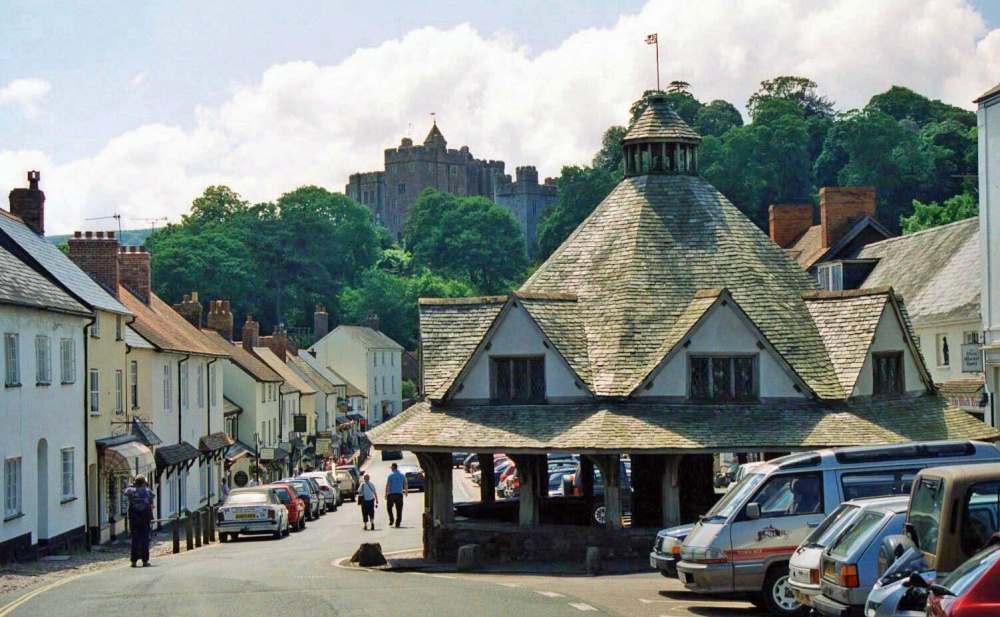
Dunster, Somerset, town - Image by PicturesOfEngland.com member Paul V. A. Johnson (view gallery)
Dunster Castle has dominated the village of Dunster for centuries. The castle is of Norman origin and belonged to the Luttrell family for over 600 years, it was presented to the National Trust in 1976.
Few villages can be more enchanting than Dunster, where every turn brings fresh delights. Some of the buildings here date from the 13th-th century. There is a medieval pack horse bridge that spans the River Anvill, two 13th-century buildings are The Old Nunnery and a tithe barn and dovecot. The watermill which still works is from the 17th-century. In 1645, during the Civil War, the beautiful Yarn Market was damaged in the firing. The building is well preserved and the damage remains visible to this day.
The sand and shingle shore here is overlooked by Conygar Hill, a densely wooded area that is rich in wildlife, it is a peaceful place and the silence is disturbed only by the shrill shriek of gulls as they circle the air above.
Dunster is pleasantly situated between the resorts of Watchet and Minehead. Local attractions include, Cleeve Abbey, Combe Sydenham Hall and Tarr Steps.
ID#436
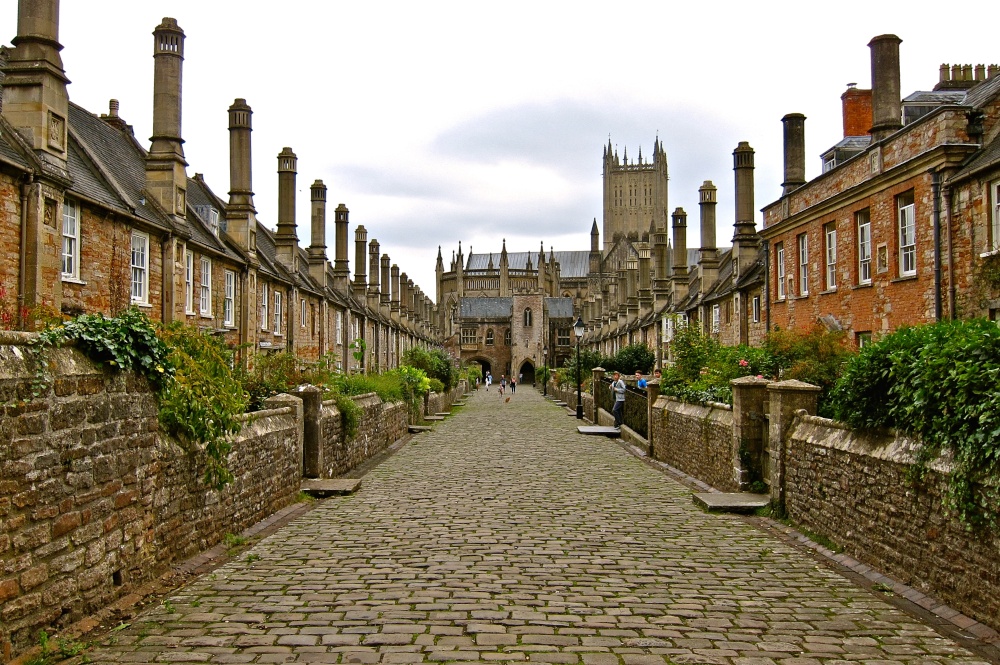
Vicars Close, Wells, UK - Walking Out - Image by PicturesOfEngland.com member Patricia Anne Kidd (view gallery)
Wells, situated at the foot of the picturesque mendip hills, is most certainly one of England's most delightful cathedral cities.
The cathedral buildings date 13th - 15th century and the impressive cathedral west front is adorned with many statues. The hallowed interior of the cathedral is an absolute joy for it has a wonderful branching staircase which leads to the chapter house and a 14th century clock.
There are many other buildings associated with the cathedral among which is the famous Vicars Close with its beautifully preserved 14th century houses each topped with a magnificent tall chimney.
Cross the cathedral green and you will find the moated Bishop's Palace where the famed Well's swans ring a bell sited near the draw-bridge for food.
All of these very fine buildings form part of one of England's largest medieval ecclesiastical precincts.
There are many other interesting buildings in and around Wells, not least the buildings which form the well known Royal Wells School of Music.
Local attractions include Wookey Hole, Cheddar Caves and nearby Clarke's Village in Street.
ID#213
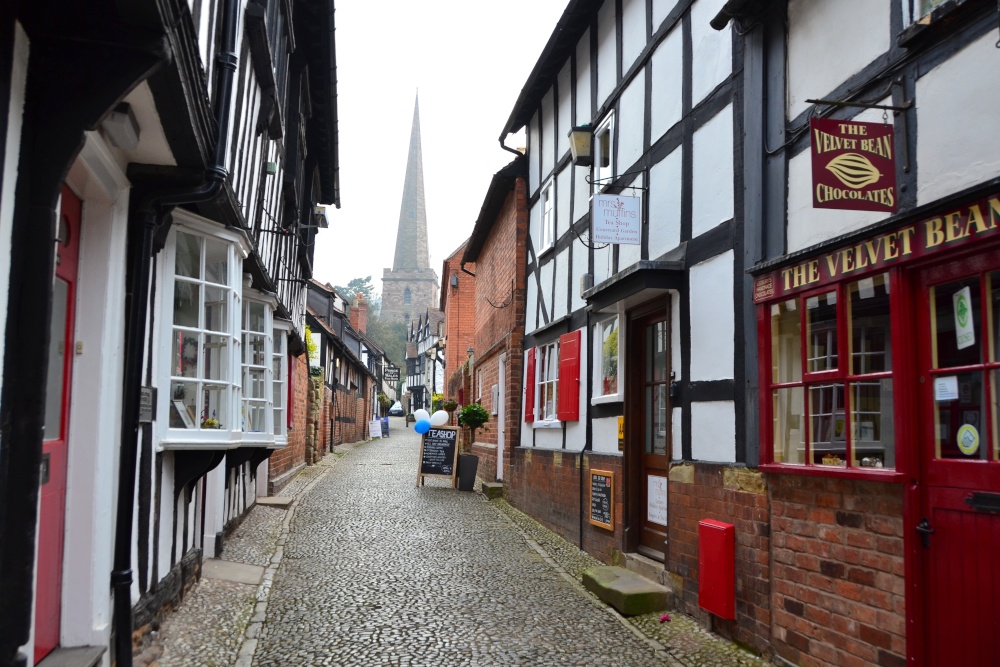
Church Lane - Image by PicturesOfEngland.com member Martin Humphreys (view gallery)
Ledbury is an attractive town whose centre has changed very little over the years. The Old Grammer School and Butchers Row cottage are but two of Ledbury's beautifully preserved Medieval buildings to be seen in the cobbled street, known as Church Lane. To the top of Church Lane is the richly decorated 12th-century church of St. Michael and All Angels.
In the busy High Street stands the beautiful old 17th-century, Market House which is supported by chesnut pillars. Just opposite is the Feathers Inn which dates 16th-century and has many fine features from this period.
Ledbury is a town to visit at any time of year and is exceptionally pleasing on Boxing day, when the local Hunt meets outside the Feathers and all the towns folk gather in Victorian costume. Morris dancers gather to entertain on the huge old slabs beneath the ancient Market house. Ledbury was the birth place of the poet John Masefield (1878-1967) and each summer this is commemorated by the town hosting a Poetry festival.
ID#383
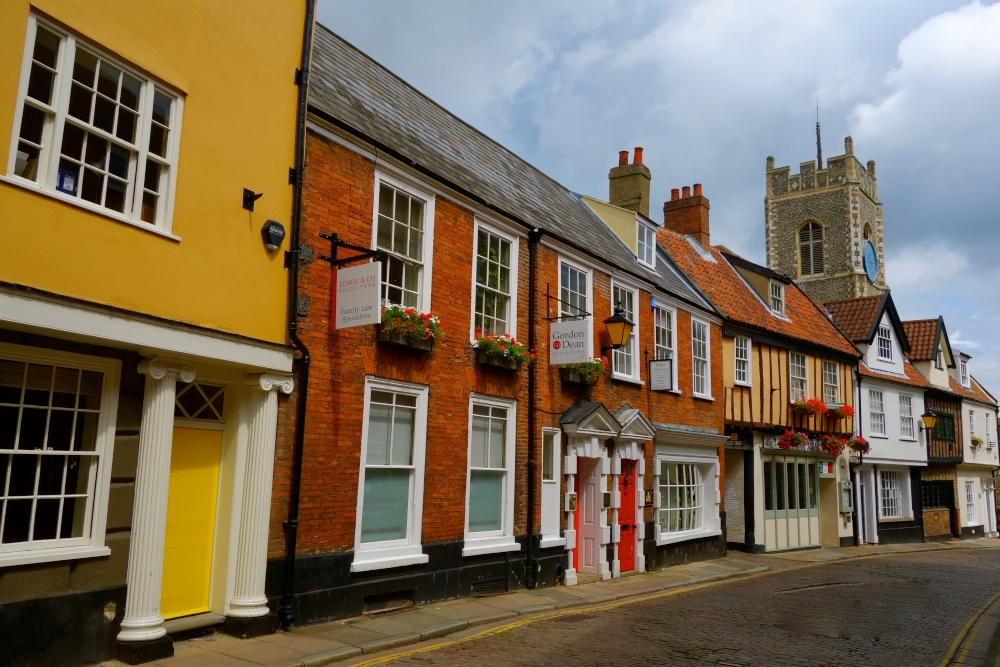
Norwich, Norfolk - Image by PicturesOfEngland.com member Kip Bennett (view gallery)
Norwich is one of England's most beautiful cities, it is a rich tapestry of modern style mixed with plenty of echoes of the past, all preserved for future generations to come. It has culture and sophistication coupled with an old world charm defined by the colourful buildings of cobbled Elm Hill where shadows are cast by quaint Victorian hanging lamps.
Exceptional countryside surrounds the city, the Norfolk Broads National Park lies at its edge and the River Wensum, part of the Norfolk Broads, flows through the city, opening up pleasant river-scapes with wildlife, pleasure boats and pretty flower-decked riverside pubs.
Overseeing all that goes on in this fine city is one of the countries most stunning cathedral buildings which was begun between 1094-96, this is a major historical treasure chest with much to amaze and delight visitors. Norwich Castle standing proudly above the town is of equal merit, this dates back to Norman times and has dungeons and death masks belonging to executed prisoners. Grandeur is all around, streets have clutches of medieval buildings, some typical of the Norfolk region with lovely over-hanging bays. There is much Victorian architecture to be seen, and the beautiful Town Hall is a triumph of Art Deco design.
In stark contrast to all of this is the cities modern facilities, Castle Mall for shopping, and there is not much in any town to beat the modernity of Norwich's 21st century landmark - The Forum. The youthful atmosphere of the city is perhaps largely due to its thriving University which attracts students from many parts of the world.
Norwich has everything to entice the visitor, a colourful street market adds to the pleasure of shopping, an abundance of cafe's, restaurants, gardens to rest in, galleries to tour, nightclubs for entertainment, along with cinema and theatre. It is also believed to have more medieval churches than any other place.
Whatever your taste there will always be something in Norwich to please. It is an ideal destination to experience a fascinating weekend of culture, or a magical place to visit whilst boating on the Norfolk Broads.
ID#17514
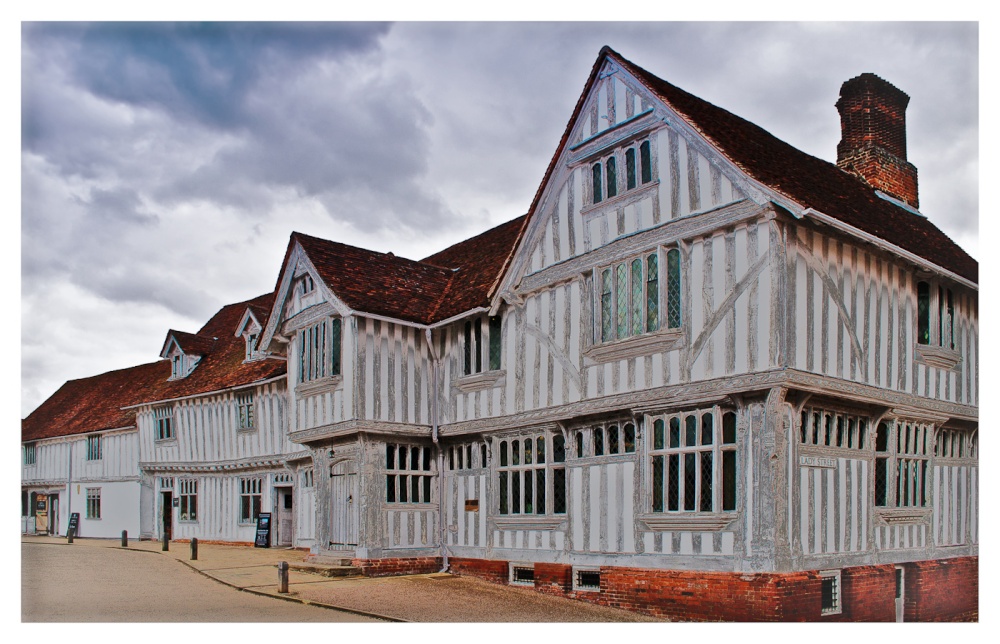
Lavenham, Suffolk - Image by PicturesOfEngland.com member Tony Snell (view gallery)
Lavenham in the county of Suffolk is one of the best preserved medieval villages in England and is famous for its stunning array of medieval buildings throughout the village, including its 15th century church and a hotel from the same period. The old grammar school, and Little Hall, which was first built in the 1300's. There are many pretty streets in Lavenham to wander around, notably Lady Street, which leads to the wonderful Lavenham Market Square.
ID#228
| Article Title | Author | Date |
| 10 of the best villages to visit in the Peak District, England | poe | 28th July 2020 |
| A look at some of the most famous views in England... | poe | 16th May 2020 |
| THE TRIAL OF THE PYX | Paul V. A. Johnson | 19th August 2019 |
| The Best Sandy Beaches in Dorset | poe | 7th June 2016 |
| 20 Of The Best Market Towns In England | poe | 1st June 2016 |
| A Human Heart and a Ghost Story in a Northamptonshire Church | Charles Moorhen | 30th October 2009 |
| Exploring the English Village Churchyard | Charles Moorhen | 29th October 2009 |
| Local Legends - The Basingstoke Burial | poe | 28th February 2008 |
| The Hidden Churches of Somerset | Louise Simmons | 6th February 2008 |
| Traditional Gloucestershire | John Ravenscroft | 6th February 2008 |